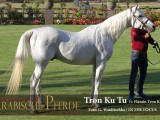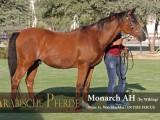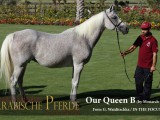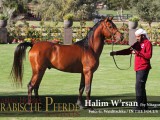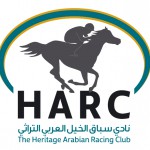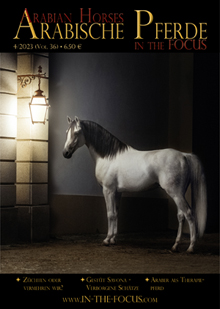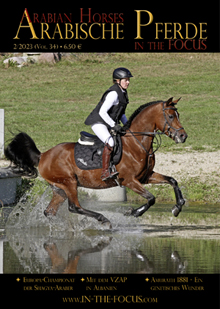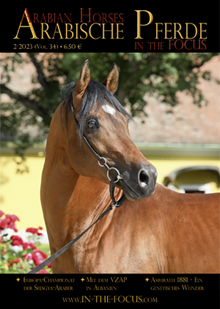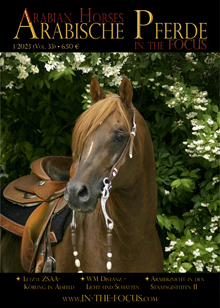Giving traditional racing lines a future, is one of the goals of the Heritage Arabian Racing Club (HARC). With the racing scene being dominated by few bloodlines from France, Saudi Arabia and US, the traditional bloodlines that often characterized the breeding of a whole nation, such as Poland and Russia, are at the brink of disappearance. HARC, the initiative of Sheikh Sultan, tries to give them back their value.
About a year ago, the Heritage Arabian Racing Club (HARC) was founded by HH Sheikh Sultan Bin Zayed Al Nahyan in Abu Dhabi in order to “to preserve the classic characteristics of the purebred Arabian horse”. To do so, it has been agreed that a HARC horse is any purebred Arabian registered in any WAHO accepted stud book which does not contain the blood of the following stallions in any generation of its pedigree. Stallions excluded: Amer, Baroud III, Burning Sand, Dragon, St.Laurent and Tiwaiq. In forming this definition, HARC does not intend to imply the superiority or inferiority of any bloodline and it recognises WAHO as the ultimate registration authority. Rather HARC aims to encourage the racing of all Arabians as part of a selection test as has been carried out traditionally in various countries over centuries to preserve the breeds distinctive characteristics and qualities equally with speed. To reach this goal, for the first time in 2015 sponsor money was paid to these member countries.
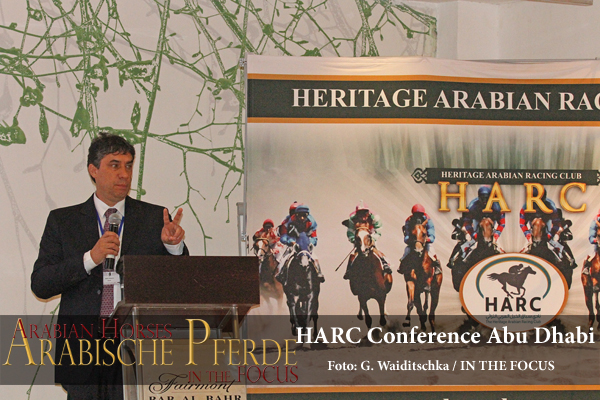
HARC-Meeting and Overview
In February this year, the representatives of eleven racing clubs from all over the world met in Abu Dhabi to discuss the present state of racing with traditional bloodlines in their countries. From their reports, it became evident, that the situation differs from country to country. Some countries, like Australia and Brazil, are pretty new into the racing business, and have hardly any “problem horses”, e.g. 99% of the bloodlines in Australia are HARC eligible. In these countries the sponsorship of HARC is used to create interest in racing Arabian horses in general. Also in the United States, incentives are created for new people from the show horse community to join racing. The incentives include seminars, webinars and key events for growing the sport.
Great Britain had seen a decline in the Arabian horse racing population over the last 5 years. Unfortunately only 12 horses are eligible for HARC at the moment, too few to held proper HARC races. Therefore they introduced a bonus scheme to stimulate interest. Of their 67 Arabian races, 40 had a HARC bonus attached. Another idea is to target endurance people to encourage them back into racing with HARC horses. The situation in Russia is similar, where they have an established racing tradition, but the vast majority of the (approx.) 200 horses in training last year have the “excluded stallions” in their pedigrees; only a total of 22 race horses had a HARC pedigree. Nevertheless, they were holding 4 successful HARC races last year and the incentive of HARC bears fruits, as now the breeders are looking for HARC horses to return to racing: For 2016 about 50 HARC horses are expected in training and Tersk Stud has purchased 7 HARC eligible stallions to ensure the survival of certain lines. In Belgium they face similar difficulties, as there are so few HARC horses available in Europe. There are now 6 horses in training in Belgium as a result of HARC sponsoring.
Much better is the situation in Poland, where there is an established racing scene with 315 HARC horses, and 214 races were held on 3 tracks. Private breeders had already trying other ideas for show horses to go racing, so there is definitely interest for HARC races, provided they do not contravene European rules. Similar in Egypt, where there were 240 horses registered to race in 2015, most of which were of Egyptian bloodlines. In Tunisia, 400 races were run in 2015 with 10-12 horses in each race. They have preserved 25% of their heritage bloodlines (see also the article about “Desert Arabians in their homelands” in this issue) and used their sponsorship for one race only, rather than to split it in many small amounts. Morocco appears to be one of the main racing countries for Arabians, they held 556 open Arabian races, but their race horse breeding programs are heavily influenced from France. Nevertheless they plan to include HARC races in the future.
Adding Value to the Horses
It is interesting to see – and important to understand – that the situation in each country is different. For some there is no imminent danger of losing their heritage bloodlines, for others it is five to twelve, or even five past twelve. But why, from a genetic point of view, would one need to preserve bloodlines for racing that are not fast enough to compete with e.g. the French race horses of Manganate descent?
For decades if not centuries, racing in countries like Poland and Russia was not done to select the fastest horse, but to maintain those characteristics of the Arabian horse that are “invisible”: Muscle formation and texture, hardness of the ligaments and tendons, as well as functionality of the heart and lungs – this is what’s called constitution. The nature of these “inner values” can be seen only under stress, such as in race training. By concentrating on just a few bloodlines that excel in racing and earn the big money, the heritage lines despite all their inner values will get lost, as they don’t earn any money. With giving them an opportunity to race among their peers, and give the winner some money, the breeders will continue to breed them. Russia is a good example, where the number of horses in training has doubled, since last year, just because there is the prospect of earning some money also with the heritage bloodlines. Also very often, breeders feel emotionally more attached to them – being a national heritage – than to any imports.
Of course, the “general racing fraction” is looking critically at HARC, and some even feel discriminated, as they claim, HARC is discriminating certain bloodlines. But why not? Anybody organizing shows only for Straight Egyptians is discriminating other bloodlines. Wherever there is restriction, there is discrimination – but as long as nothing is taken away from the “general racing fraction”, but added at certain points, there is no need to panic. Especially, as this movement could bring back race enthusiasts that have given up racing, or bring in new people to the world of racing – which in the end will be beneficial for the “general racing fraction”, too! And so, the purpose of this Club is to support and promote racing for those who wish to preserve the purebred Arabian of traditional type and bloodlines and to ensure the long-term future of Arab horse characteristics, in the broadest terms, with the hallmarks of beauty, athletic ability, soundness and versatility.
Visiting W’rsan Stables
To see what’s it actually all about the meeting was invited to the W’rsan Stables, the studfarm of HH Sheikh Sultan Bin Zayed Al Nahyan. Here, he breeds racing and endurance horses of traditional bloodlines. The stud came into life when Sheikh Sultan bought the racing legend Monarch AH (Wiking / Sasanka) together with some of the best horses of Magnuss Arabians in USA, some top class Russian broodmares and recently also some Russian stallions, Dilijans and Nitagor. Of course, most of the visitors knew about the “living legend” Monarch AH and his achievements. He won no less than 19 out of 23 races and won more than 200.000 USD back in the early 1990s. He has a pure Polish pedigree and comes from the best Polish racing line, Sabellina. It was good to see that he is still going strong, despite his age of 29 years. Another senior stallion is Tron Ku Tu, born 1990, son of Flaming Tron Ku, the latter also a racing legend in US with life earnings of over 100.000 USD during 25 races of which he won 17. The more recent acquisitions came from Russia and include the beautiful stallion Nitagor (by Gordon) from Tersk Stud and Dilijans (by Anchar) bred in Chrenovoje. Dilijans won 9 out of 10 races before he was sold in 2014 to the UAE. After our visit, yet some more stallions from Russia arrived, Dostatok (by Status) with life earnings of over 1,7 Mio Rubles and Nargil Tersk (by Gabon), the latter is presently being trained for the race track. Apart from racing, there are always several horses in training under saddle and perform very well in Dressage. They are even regular guests now at events in Europe, and Al Khattar W’rsan won two Bronze Medals at the European Championships last year in Janow Podlaski, while Muteeaa W’rsan got three Gold Medals at this years open Austrian Championships (see page 54), both horses ridden by Line Moen.
Sheikh Sultan aims at horses that are beautiful athletes. Therefore, all his horses undergo some training in racing, endurance or dressage, before they are joining the breeding barn. The fact that both Dressage horses mentioned above are sired by the racehorse sire Monarch AH, shows, that breeding for performance does not need to specialize for only one discipline. As long as you are not aiming for the extremes, but stick with the traditional bloodlines and following the traditional selection procedures, you will get a versatile athlete, which the Arabian horse has been since Bedouin times.
Gudrun Waiditschka






